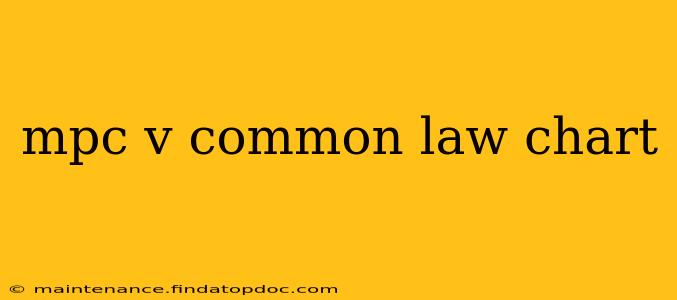MPC vs. Common Law: A Comparative Chart and In-Depth Analysis
Understanding the differences between the Model Penal Code (MPC) and common law approaches to criminal law is crucial for anyone studying or practicing in the legal field. While the MPC isn't law itself (unless adopted by a specific jurisdiction), it serves as a significant influence on state criminal codes and provides a valuable framework for comparison. This article will provide a detailed comparison, addressing common queries about the nuances between these two systems.
What is the Model Penal Code (MPC)?
The Model Penal Code, drafted by the American Law Institute (ALI) in the mid-20th century, aims to standardize and modernize criminal law across the United States. It's not a federal law; instead, states can choose to adopt all or parts of the MPC into their own criminal codes. Many states have incorporated aspects of the MPC, resulting in a blend of MPC principles and traditional common law approaches.
What is Common Law?
Common law is a legal system based on judicial precedent, meaning that legal principles are developed through court decisions over time. In criminal law, this means that crimes and their associated punishments are defined and refined through case law, rather than through codified statutes. The evolution of common law is often gradual and influenced by societal changes and interpretations of existing legal principles.
Key Differences: A Comparative Chart
| Feature | Model Penal Code (MPC) | Common Law |
|---|---|---|
| Source | Statutory (drafted by ALI, adopted by states) | Judicial precedent (case law) |
| Mens Rea | Specific definitions for different mental states (purposely, knowingly, recklessly, negligently) | More flexible, relying on terms like "malice aforethought," often less precisely defined. |
| Actus Reus | Clear articulation of required acts or omissions | Defined through case law, potentially leading to more varied interpretations. |
| Strict Liability | Limited instances of strict liability offenses | More prevalent in common law, particularly for certain regulatory offenses. |
| Defenses | Detailed provisions for defenses like insanity, duress, and mistake | Defenses developed through case law, potentially leading to inconsistent application. |
| Sentencing | Often provides sentencing guidelines, although specific sentencing remains within judicial discretion. | Historically more discretionary, although sentencing guidelines are becoming more common. |
Frequently Asked Questions (FAQs)
1. What are the main differences in the definition of mens rea between the MPC and common law?
The MPC offers a more precise and codified approach to mens rea, defining four distinct mental states: purposely, knowingly, recklessly, and negligently. This clarity aims to reduce ambiguity in determining criminal culpability. Common law, in contrast, often relies on less precise terms like "malice aforethought," leading to potentially inconsistent interpretations across different jurisdictions and cases.
2. How does the MPC approach actus reus differ from the common law system?
The MPC strives for a clearer and more comprehensive definition of actus reus (the guilty act), specifying the required acts or omissions for each crime. This codified approach aims to provide more predictability and consistency in the application of the law. Common law, dependent on case-by-case development, offers a more fluid and potentially less consistent definition of actus reus, relying on judicial interpretation.
3. How do the approaches to criminal defenses differ between MPC and common law jurisdictions?
The MPC provides detailed and structured provisions for various defenses, including insanity, duress, mistake of fact, and self-defense. This standardization aims to ensure consistent application across different cases. Common law, on the other hand, relies on the gradual development of defenses through case law, which may lead to greater inconsistencies across jurisdictions and a less predictable outcome.
4. Which system is considered more flexible, the MPC or common law?
Common law offers greater flexibility because it allows for adaptation and interpretation based on evolving societal norms and specific case circumstances. The MPC's codified nature, while providing clarity and consistency, offers less room for immediate adaptation to unique circumstances.
5. Does the MPC completely replace common law in jurisdictions that adopt it?
No, adoption of the MPC doesn't entirely replace common law. Many states adopt parts of the MPC while retaining elements of their existing common law traditions. The result is often a hybrid system incorporating both codified statutes and judicially developed principles.
Conclusion:
The MPC and common law represent distinct approaches to criminal law. The MPC strives for clarity, consistency, and standardization through codified statutes, while common law evolves organically through judicial decisions. Understanding these differences is crucial for legal professionals navigating the complexities of criminal justice in the United States. The continued influence of the MPC highlights its success in providing a modern and coherent framework for criminal law, even as jurisdictions maintain the flexibility offered by common law principles.
